29.05.2006
Sergey Klimov. Dagomys cutting, rounds 8-11.
I think it is not a great secret that both commentators and amateurs had difficulties obtaining games of the majority of the Premier league players, not to mention all games of the Higher league. This issue was discussed on our site as well as on other websites. Since the second Aeroflot open, publishing only those games that were demonstrated on electronic boards became a sweet habit of many organizers.
This time, however, some games of the Higher league became available, even if only by the end of the competition, and I figured it is a good thing to highlight the most spectacular ones in the end of my review. Now let's go back to the Premier league action.
Najer-Bareev (round 9)
1.d4 d5 2.c4 c6 3.¤c3 ¤f6 4.¤f3 e6 5.Ґg5 ¤bd7
If the memory does not fail me (together with the database), this position has never occurred in “Black” practice of Evgeny Bareev.
6.e3 Јa5 7.Јc2 Ґb4 8.¤d2 0-0 9.Ґe2 c5

10.Ґf4!?N
An interesting way to retreat the bishop, apparently, preventing the Black's queen from landing on c7. Normally White retreats to h4, keeping the Black's knight on d7 by threatening to capture on f6. For example, 10.0-0 cxd4 11.exd4 dxc4 12.Ґh4 ¤b6 (12...Јb6 13.¤xc4 Јxd4) 13.Ґxf6 gxf6 14.¤xc4 ¤xc4 15.Ґxc4 Ґd7 16.d5 Ґxc3 17.dxe6 Ґxe6 18.Ґxe6 fxe6 19.bxc3 ¦ac8 - an old and more or less forced variation that is known since 90s.
There are other attempts of playing for advantage. For instance, 10.¤b3 Јa4 11.Ґxf6 ¤xf6 12.dxc5 dxc4 13.Ґxc4 Јc6 14.0-0 Ґxc5 15.¤xc5 Јxc5 16.¤e4 ¤xe4 17.Јxe4 Јb6 , and one has to sacrifice a pawn in order to hold Black's development: 18.¦ad1 Јxb2, van Weky-Bacrot, Götenborg, 2005;
10...cxd4 11.exd4 dxc4 12.¤xc4 Јd5 13.0-0 Јxd4 14.Ґg3

Threatening 15.¦fd1 Јc5 16.Ґd6. With his next move Black vacates a square for the queen.
14...Ґxc3
15.bxc3 Јe4 16.Јb2 Јc6
Lamprecht-Beckemeier, Bundesliga 2000 continued 16...¤b6 17.¤xb6 axb6 18.¦fd1 e5 19.Ґd3 Јc6 20.Ґxe5І , which by no means can satisfy Black.
17.¤d6 ¤e4 18.¤xe4 Јxe4 19.¦ad1
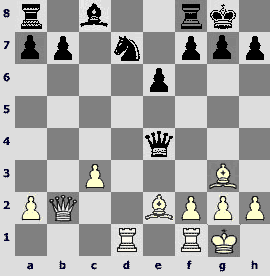
White threatens nothing, but Black must develop somehow!
19...Јf5 20.Ґd6 ¦e8 21.c4 e5
The idea is clear – Bareev wants to play b7-b6, and on Ґf3 – e5-e4. However, White finds another way to counter the b7-b6. The d7-knight has no alternative squares: 21...¤c5 22.g4+-; 21...¤b6 22.c5 ¤d5 23.Ґb5 ¦d8 24.Ґe7+-.
22.c5
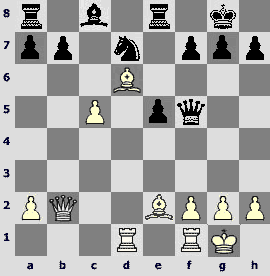
22...b6
Bad is 22...¤f6 23.Ґb5 Ґd7 24.Ґxd7 ¤xd7 25.Јxb7±.
23.c6 ¤f6 24.¦fe1
Najer plays strictly according to his plan, as Black cannot improve his position.
24...e4 25.Јd4 Ґe6
An extreme move – White controls the a6-square, so the c6-pawn can only by stopped at cost of a piece. However, Irepeat, onecannot do without developing pieces.
26.Ґa6 Јd5
26...Ґc8 27.Ґb7+-
27.Ґb7 ¦ad8 28.Јb2 Јa5 29.Ґb4
29.c7 ¦xd6 suddenly loses – a small trap by Bareev!
29...¦xd1?
The resistance could be continued after 29...Јf5 30.¦xd8 ¦xd8 31.c7 ¦e8 32.Јd4 – Black suffers badly with the White's pawn on c7, but does not lose immediately.
30.Ґxa5
Black resigned.
The game draws attention to a possibly underestimated method of dealing with the Cambridge-Springs Variation.
Don't you agree that at some point this game begins leaving a strange impression? It seems like all Black's attempts to develop his pieces hit on him. There won't be the c-passer without b7-b6, there won't be such a powerful domination without the dark-squared bishop being exchanged on c3, etc. In my opinion, we should return to this exchange in our attempts to improve the Black's play.

Clearly, the Black's queen experiences problems, to say the least. Black would have been okay if he could solve this problem.
However, it should not be moved too far: 14...a6 15.¦fd1 Јa7 16.Ґf3, and Black will run out of moves soon.
Of course, one can play 14...Ґe7 15.¦fd1 Јc5, but one is reluctant to move backwards, and the queen is still in danger.
After a lengthy though I believe we should pay attention to 14...e5 – Black will have to part with a pawn sooner or later anyway, and with this move he hopes to get a standard for the Queen's Gambit "+=/=".
White has the following options:
15.¤xe5 ¤xe5 16.¤b5 Јc5 17.Јxc5 Ґxc5 18.Ґxe5 ¦e8 – White has recaptured a pawn, but the bishops are poorly placed on the e-file.
The most natural move is, of course, 15.¦fd1, then 15...Јc5 16.¦ac1 (16.¤d6 Јb6 17.¤f5 with compensation deserves attention), and now 16...Ґxc3 is not bad: 17.Јxc3 (17.bxc3 b6 – the g3-bishop is cut off, Black has a bearable position), and now 17...¤e4 18.Јf3 ¤xg3 - the bishop is exchanged, and completing the development at cost of a pawn isn't difficult: 19.Јxg3 Јe7 20.Јe3 ¤b6 21.Јxe5 Јxe5 22.¤xe5 Ґe6= 23.¦c7 f6 or 23.b3 f6.
15.¤b5 is trickier, aiming at utilizing the misplaced b4-bishop.
Now after 15...Јc5 16.a3 (16.¤bd6 b5) 16...Јxb5 17.¤xe5 Јc5 18.¤c4 Ґxa3 19.¦xa3© White has a good compensation for a pawn. Perhaps more solid for Black is 15...Јe4 16.Ґd3 Јc6 17.¤xe5 Јxc2 18.Ґxc2, and now, instead of 18...¤h5 19.¦fd1, Black plays 18...¤xe5 19.Ґxe5 Ґd7 20.¤d6 Ґc6 and equalizes.
All in all, after the sacrifice Black does not lose, but he'll have to find a few accurate moves.
Rublevsky – Volokitin
1.e4 c5 2.¤f3 d6 3.d4 cxd4 4.¤xd4 ¤f6 5.¤c3 a6 6.g3
Rublevsky preferred 3.Ґb5+ or 6.Ґc4 earlier.
6...e6 7.Ґg2 Јc7 8.0-0 Ґe7 9.g4 h6 10.f4 ¤c6 11.¤xc6
Less a mbitious is 11.¤b3.
11...bxc6 12.e5 dxe5 13.fxe5 ¤d7
This is a more Sicilian move than 13...¤d5 14.¤e4 , and if 14...Јxe5, then 15.c4.
14.Ґf4 Ґb7 15.Јf3
Maybe White should have developed the queen on e2, without trying to be original.
15...¦b8
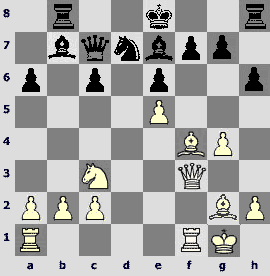
16.Јh3!?
Not good is 16.¤e4 c5 17.¤d6+ Ґxd6 18.exd6 Јb6 19.Јf2 Ґxg2 20.ўxg2 Јc6+ 21.ўg1 0-0 …e6-e5. One can try 17.b3 c4 or 17.Јc3 c4, but Black obtains a comfortable game in both cases. White sensibly figures that since the queen has to leave the h1-a8 diagonal in any case, it is better done with the idea of g4-g5.
16...Ґc5+
Also here 16...c5 deserved attention.
17.ўh1 Ґd4
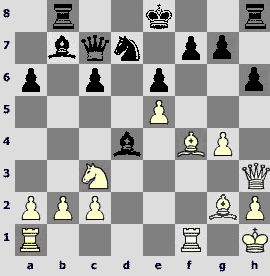
18.¤e4
Forced.
18...Ґxe5 19.Ґxe5 ¤xe5 20.¦ad1 0-0 21.g5™ c5 22.gxh6
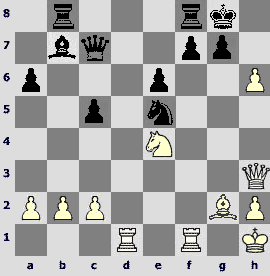
22...Ґxe4
22...f5!? 23.hxg7 Јxg7 24.¤xc5 Јxg2+ 25.Јxg2+ Ґxg2+ 26.ўxg2 ¦xb2 27.¤xe6 ¦xc2+ 28.¦f2=.
23.Ґxe4
23.hxg7 Ґxg2+ 24.Јxg2 ¦fd8
23...g6 24.Јg3!

Initially I evaluated this position as favorable for Black – his central pawns look threatening. However, it is not at all simple due to the vulnerable e5-knight.
24...¦b4
Bad is 24...¦xb2 25.Ґxg6! fxg6 26.h7+! Јxh7 27.¦xf8+ ўxf8 28.¦d8+ ўe7 (28...ўg7 29.Јxe5++-) 29.Јg5+ ўf7 30.Јf4+ ўg7 31.Јf8#.
25.¦de1
Alas, 25.Ґxg6? is met by 25...¦g4-+.
25...f5
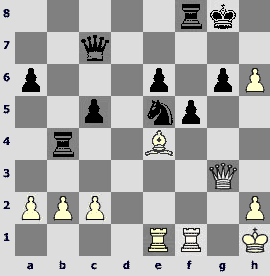
26.Ґf3
26.Ґxf5 Јb7+ 27.Јg2 ¦xf5 28.¦xf5 exf5 29.Јxb7 ¦xb7 30.¦xe5 ¦xb2 31.¦xc5 ўh7 is unpleasant for White, although the draw is within the reach.
If White wanted to relieve the tension, he would have played 26.c3 ¦xe4 (26...¦xb2 27.Ґg2 ¦xg2 28.Јxg2І) 27.¦xe4 fxe4 28.h7+ Јxh7 29.¦xf8+ ўxf8 30.Јxe5 – the pawn is regained, and although the endgame is probably drawn, White can safely play for a win.
26...f4
Yielding the e4-square to the enemy bishop, but it can't be helped.
27.Јg2 ¦f6 28.Ґe4
28.c3 ¤xf3 29.¦xf3 ¦b6.
28...¦b8 29.¦f2
With the idea of attacking on f4. Another plan - h2-h4-h5 – was too risky because it weakens the king's shelter.
29...¦bf8 30.Јg5 ўh8 31.b3 Јd6 …Јd4 32.c3 ўh7 33.¦ef1

Volokitin hesitated for a while, moving his king back and forth, but as the f4-pawn is attacked, he decides to sacrifice and exchange.
33...¦f5 34.Јg2
Rublevsky declines the offer. 34.Ґxf5 ¦xf5 35.Јg2 f3 (35...g5 does not protect on f4 – the capture is still possible) 36.Јg3 Јd5©

This can hardly please White – Black is very active, and it is unclear how White can activate his rooks. Nevertheless, the exchange had to be taken.
34...f3 35.Јg3 ¦f4
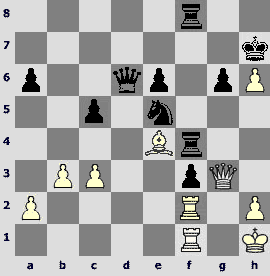
I am sure at this point Rublevsky regretted of his decline.
36.¦xf3?
Ablunder. White had to play 36.¦e1, but I do not like his position any more in any case...
36...¦xf3 37.Ґxf3 Јd3 38.ўg2
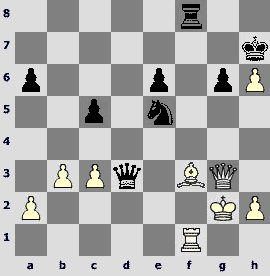
38...Јxf1+ 39.ўxf1 ¦xf3+ 0-1
So:
- Black retreated on d7 with the knight and got a good game,
- White took certain strategic risk by moving the queen to h3 and abandoning the e5-pawn,
- in the position with the light-squared bishop against the knight White was not worse and probably had to use an opportunity to play 26.c3,
- the exchange sacrifice was sound, but it still had to be accepted,
- Rublevsky probably lost his nerves in a time trouble, which resulted in a blunder.
Smirnov-Sakaev
1.e4 c5 2.¤f3 d6 3.d4 cxd4 4.¤xd4 ¤f6 5.¤c3 a6 6.Ґe3 ¤g4 7.Ґc1 ¤f6 8.f3 e6 9.Ґe3 b5 10.g4 h6 11.Јd2 b4 12.¤a4 ¤bd7 13.0-0-0 ¤e5
The Topalov variation.
14.b3
In the pioneer game of the variation Topalov defeated his predecessor in 20 moves: 12.Јxb4 Ґd7 13.¤b3 ¦b8 14.Јa3 ¤xf3 15.h3 ¤xe4 16.Ґe2 ¤e5 17.¦he1 Јc7 18.Ґd4 ¤c6 19.Ґc3 d5 20.¤bc5 Јa7, White resigns, Kramnik-Topalov, Wijk aan Zee 2005.
14...Ґd7
In the first game with 14.b3 against Anand Topalov continued 14...d5 15.Ґf4 Ґd6 16.Ґxe5 Ґxe5 17.¤c6 Јc7 18.¤xe5 Јxe5 19.Јxb4 dxe4 20.¤b6 ¦b8 21.ўb1, and Anand won a head-spinning battle. 14...Ґd7 looks better.
15.¤b2 d5 16.Ґf4
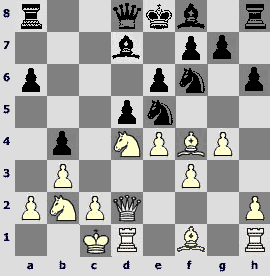
16...Јc7
This isn't anovelty. One can also play 16...¤xf3 17.¤xf3 ¤xe4 18.Јd4 f6, following Topalov and Cheparinov, but as this game shows, there is no need to sacrifice for Black.
17.Ґg3?!N
Not counting pawns. 17.¤d3 ¤xd3+ 18.Ґxd3 Јb6 19.¤e2 Ґc6 20.e5 ¤d7 21.ўb1 Ґc5 22.Ґg3 a5ѓ with the initiative, Erdogdu - Roiz, Warsaw 2005.
17...dxe4 18.f4 ¤exg4 19.¤c4
19.h3 ¤h5 (maybe White missed it) (19...e3? 20.Јg2±) 20.Ґh4 ¤gf6;
19.f5 e5.
19...¤h5 20.Јe1 ¤xg3 21.hxg3 ¦d8
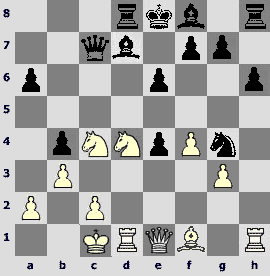
White is two pawns down and has no real compensation.
22.Ґe2 ¤f6 23.¤e5 Ґc5 24.Ґc4 Ґc8 25.c3 bxc3 26.Јxc3 0-0 27.g4 ¤d5 28.Ґxd5 ¦xd5
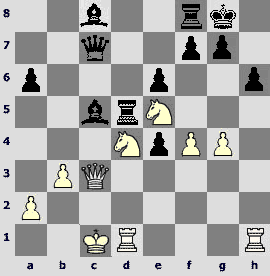
29.g5 Ґa3+ 30.ўc2 Јxc3+ 31.ўxc3 hxg5 32.¦h2 f6 33.¤g6 ¦fd8 34.b4 Ґxb4+ 35.ўxb4 ¦xd4+ 36.¦xd4 ¦xd4+ 37.ўc5 ¦d5+ 38.ўc6 ўf7 39.¤h8+ ўe8 0-1
Of course, creative value of this game is insignificant – White failed to prove correctness of his sacrifice and lost without much resistance, but this game can surely draw more attention to the 16...Јc7 line.
Sacrifices
Mamedyarov – Volkov
1.d4 d5 2.c4 c6 3.¤c3 ¤f6 4.e3 a6 5.Јc2 b5 6.b3 Ґg4 7.¤ge2 ¤bd7 8.h3 Ґxe2 9.Ґxe2 e6 10.0-0 Ґe7 11.e4
Mamedyarov's sacrifice has at least one predecessor: 11.¦d1 0-0 12.e4 b4 13.exd5 bxc3 14.dxc6 ¤b8
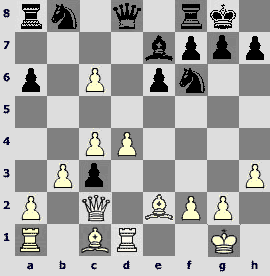
15.Ґf3 Јc7 16.d5 exd5 17.cxd5 Ґd6

18.Ґe3 a5 19.¦ac1 ¤a6 20.Јxc3 Јd8 21.Јc4 ¤c7 22.Ґc5 ¤fe8 23.a3 Ґxc5 24.Јxc5 ¤d6
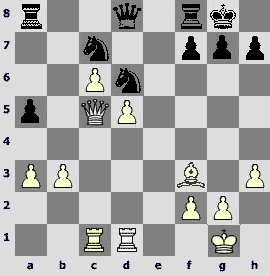
25.b4 axb4 26.axb4 ¦b8 27.Јd4 ¦e8 28.¦e1 h6 29.Јf4 ¦e7 30.Јd2 ¦xe1+ 31.¦xe1 Јh4і
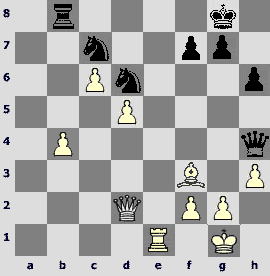
Doettling-Motylev, Mainz 2002.
The main conclusions about this game:
- the rook move to d1 was not really useful for White
- it would be nice to meet ¤d7-b8 with a move other than d4-d5, in order to prevent Black from blocking the pawns.
Mamedyarov spares a tempo on the rook move.
11...b4
This position has occurred in Sergey Volkov's practice. Playing against Dreev in the end of the previous year, he did not dare taking the piece, and won the game after maneuvering struggle: 11...dxe4 12.¤xe4 0-0 13.¦d1 bxc4 14.bxc4 Јc7 15.¦b1 ¦fb8 16.¦b3 ¦xb3 17.axb3 ¦b8 18.Ґf3 a5. Normally Volkov enjoys positions with imbalanced material.
12.exd5 bxc3 13.dxc6
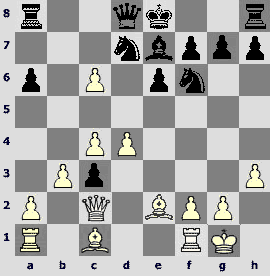
13...¤f8
Of course, 13...¤b8 14.Ґf3 Јc7 is also principled reaction. It is interesting to try 15.b4 (15.d5) 15...Ґxb4 (if the pawn advances to b5, the extra knight on b8 becomes immobile) 16.¦b1 a5 17.a3 Ґd6 18.¦b7 Јc8

My impression is that White has a very good compensation for a piece, although I cannot present supporting variations: 19.c5 (19.Ґg5 0-0 20.Ґxf6 gxf6 21.d5) 19...Ґe7 20.¦e1 …d4-d5 (20.¦xe7+ ўxe7 21.c7 ¤bd7 22.Ґxa8 Јxa8) 20...0-0 21.¦xe7 (21.Јxc3 ¤xc6 22.¦b6 ¤xd4 23.Јxd4 Ґxc5µ) 21...¤xc6.
Volkov has a different plan in mind – he allows White playing b3-b4-b5, in order to exchange on b5 and put a knight to d5.
14.Јxc3 ¤g6
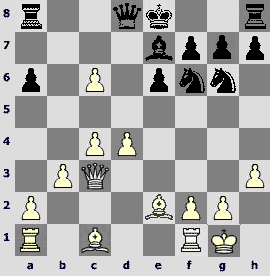
(Curious but quite risky is 14...a5!?, preventing b3-b4)
15.b4 Јb6 16.b5
Mamedyarov is not aware that allowing the knight to d5 is bad for him.
16...axb5 17.cxb5 ¤d5 18.Јc4 0-0 19.a4

White would like to play Ґd2 on the next move, and then a4-a5. Volkov prevents it. The move order cannot be inverted: 19.Ґd2 …a4-a5 because of 19...¦a3.
19...Ґb4 20.Ґf3 ¤ge7

21.Ґg5 h6
The exchanges increase the role of the passers.
21...f6 22.Јe2 ўf7, and there is a room for imagination: 23.¦fe1!? (23.Ґg4!? ¤f5 24.Ґxf5 exf5 25.Ґd2) 23...Ґxe1 24.¦xe1 e5 25.Ґd2 Јxd4 (25...¦xa4) 26.a5 – the pawns start moving, but White is already a rook down.
22.Ґxe7 Ґxe7 23.Ґxd5 exd5 24.Јxd5 ¦fd8
Knowing the game's events, one wants playing 24...Ґf6 first, but White has an extra possibility 25.a5 ¦xa5 26.¦xa5 Јxa5 27.Јc5,
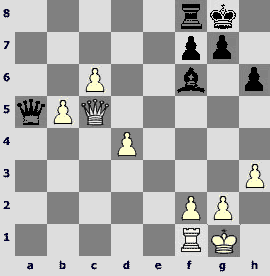
and, in order to stop the pawns, one has to play 27...Ґd8 28.d5 Ґb6 29.Јe7 (29.Јc4 ¦d8) 29...Јxb5 30.Јb7 f5 31.d6 f4 32.d7. Still there is a feeling that Black might survive with a study-like play.
25.Јe4 Ґf6
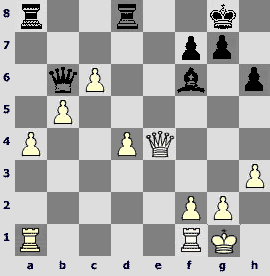
26.d5! Ґxa1 27.¦xa1
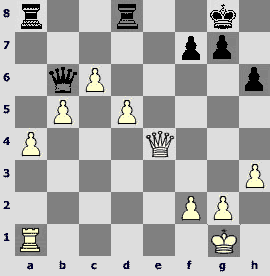
Sadly for Black, all four pawns cannot be blocked.
27...Јc5
27...¦d6 28.¦d1 Јa5 (28...g6 29.Јb4, breaking the blockade) 29.Јe7 Јxa4 30.Јxd6 Јxd1+ 31.ўh2+-.
28.¦d1 ¦e8
A desperate attempt.
29.Јf4 ¦e2 30.c7
Slightly less clear is 30.d6 ¦xa4 31.Јf3 Јc2 32.¦f1 (I even managed finding a variation with a win for Black: 32.¦d3 ¦xf2 33.d7 ¦xf3 34.d8Ј+ ўh7 35.¦xf3 Јc5+ 36.ўh2 Јe5+ 37.¦g3 ¦a3 38.Јh4 g5 39.Јg4 f5-+) 32...¦d2 33.d7 ¦b4 34.Јe3+-.
30...¦xa4
30...g5 31.Јf3+-.
31.c8¦+ Јxc8 32.Јxa4+- , and the rest is a matter of technique.
32...Јc5 33.ўh2 Јxf2 34.Јg4 ¦e8 35.d6 Јc5 36.Јd7 Јe5+ 37.ўh1 Јe2 38.¦c1 ¦f8 39.b6 f5 40.b7 ўh7 41.Јc8 Јd2 42.b8Ј 1-0
Astonishing stuff
As the championship proceeded, the collection of astonishing moves grew. Grandmasters moved pieces back and forth, as if trying to refute the outdated theory of tempi. Past masters had condemned losing tempi in numbers. As for the opinion of present chess players, you are welcome finding in the following selection.
Malakhov-Tkachiev
1.e4 e5 2.¤f3 ¤c6 3.Ґb5 a6 4.Ґa4 ¤f6 5.0-0 b5 6.Ґb3 Ґc5 7.d3 d6 8.h3 0-0 9.c3 h6 10.a4 ¦b8 11.axb5 axb5 12.Ґc2 b4 13.d4 bxc3 14.bxc3 Ґb6
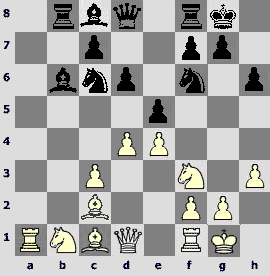
15.Ґa3 ¦e8 16.¦e1 ¤h7

17.Ґc1 Ґd7

18.¤a3 ¦a8 19.Ґb2 ¤g5 20.¤c4 ¦xa1 21.Ґxa1 Ґa7 22.¤cd2
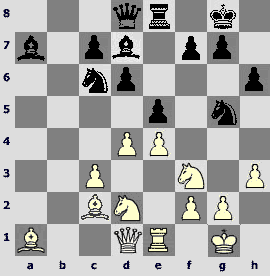
This was impossible on the 18th move, as the d-pawn was hanging.
22...¤xf3+ 23.¤xf3 Ґb6 24.Ґb3 ¤a5 25.Ґa2 Јc8 26.dxe5 dxe5 27.c4 Ґxh3
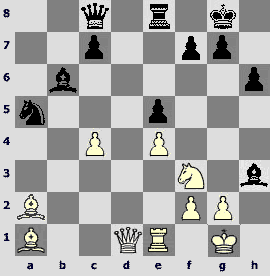
28.¤xe5
Another curious moment. The computer insists that the bishop can be taken: 28.gxh3 Јxh3 29.c5 Ґxc5 30.Ґxe5 ¦xe5 31.Ґxf7+ ўxf7 (31...ўh7 32.Ґg6+) 32.¤xe5+ ўe7 33.Јf3 with some winning chances in the endgame with an extra exchange.
28...Ґe6 29.Јc2 ¤b7 30.¤d3 ¤c5 31.¤f4 Јd8 32.¤d5 Ґxd5 33.cxd5 Јh4 34.g3 (34.Јc3!?) 34...Јg4 35.e5 ¦a8 36.e6 ¤xe6 37.dxe6 Јxg3+ 38.ўf1 Јh3+ 39.ўg1 Јg3+ 40.ўf1 Јh3+ 41.ўg1 Ѕ-Ѕ
Zvjaginsev-Ivanchuk
1.e4 c5 2.¤f3 ¤c6 3.Ґb5 e6 4.0-0 ¤ge7 5.¦e1 a6
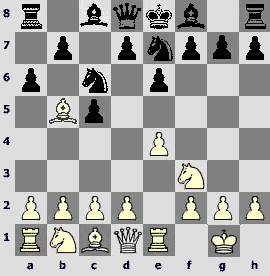
6.Ґf1 (ambushing) 6...d5 7.d3
Nearly everyone plays 7.exd5, and after 7...¤xd5 – 8.d4. Mikhail Ulibin found an original response to 7...Јxd5 (aiming against d2-d4): 8.Ґd3!?.
7...g6 8.Ґg5 Ґg7 9.c3 h6
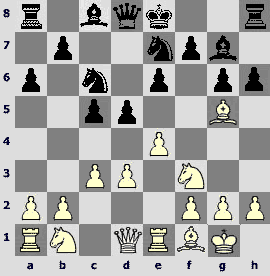
10.Ґc1 (the bishop returns after forcing an important weakening of the Black's queenside) 10...Јc7
I think locking the center by 10...d4 and e6-e5 was justified.
11.h4 e5
It does not seem like Ivanchuk thinks that he can claim any advantage, as the Ukrainian begins an exchanging operation with this move.
12.exd5 ¤xd5 13.¤ xe5 ¤xe5 14.d4 cxd4 15.cxd4 Ґe6 16.dxe5 Ґxe5 17.Јa4+ ўf8 18.¤d2 ¦e8 19.Јc4 ¦d8 20.Јxc7 Ґxc7 21.a3 Ґb6 Ѕ-Ѕ
Fragments
Mamedyarov-Brodsky
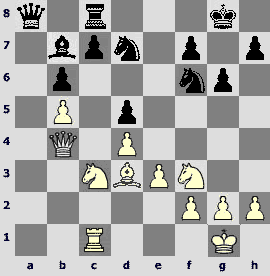
Black stands worse of course, but it is hard to believe that in 8-10 moves he'll have to parry mating threats.
19.h3 Јa7 20.g4! ¦a8 21.¤e2 Јb8 22.g5 ¤e8 23.¤f4 Јd8 24.h4 ¤f8 25.Ґf1 ¦a5 26.¤e5
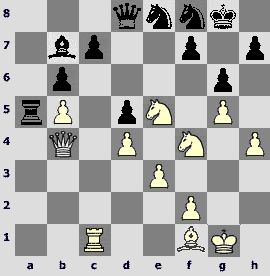
26...h6?!
This break plays into White's hands.
27.gxh6 ¤h7
27...Јxh4 28.Јxf8+ ўxf8 29.¤fxg6+ fxg6 30.¤xg6++-.
28.h5 g5 29.¤fg6 ¤d6
29...fxg6 30.hxg6 ¤hf6 31.h7++-.
30.Јc3 ¤e8 31.¤c6 Ґxc6 32.Јxc6+- ¤hf6 33.¤e5 Јe7 34.Ґd3 ¦a3 35.h7+ ¤xh7
35...ўg7 36.h6+ ўh8 37.Ґg6+-.
36.Ґxh7+ ўxh7 37.Јxd5+- ¤d6 38.¤c4 ¤xc4 39.¦xc4 ўh8 40.Јf5 ¦a8 41.¦c6 ўg7 42.h6+ ўh8 43.¦xc7 1-0
Turov-Riazantsev
1.d4 ¤f6 2.c4 e6 3.¤c3 Ґb4 4.Јc2 c5 5.dxc5 0-0 6.¤f3 ¤a6 7.Ґd2 ¤xc5 8.a3 Ґxc3 9.Ґxc3

9...b6?
Normal moves are 9...¤ce4 and 9...h6.
10.¤g5 g6 11.b4 ¤b7 12.h4 ,
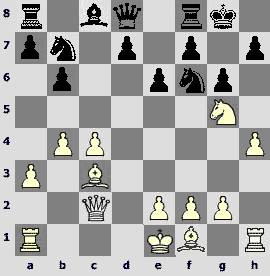
and the assessment is between 'big advantage' and 'won' for White.
12...d6 13.h5 e5 14.hxg6 hxg6 15.Јd2 ¤h5 16.¦d1 Јe7 17.g3
It is unclear why White refuses 17.¤e4 Ґf5 (17...f6 18.¤xd6; 17...¦d8 18.Јh6 …¦:h5) 18.¤xd6 ¤xd6 19.Јxd6 Јxd6 20.¦xd6+-.
17...f6 18.¤e4 Ґe6 19.Јd3
19.Ґg2 ¦ac8 (19...Ґxc4 20.Јh6) 20.Јh6 Јg7 does not win.
19...¦ac8 20.¤d2 ўg7±
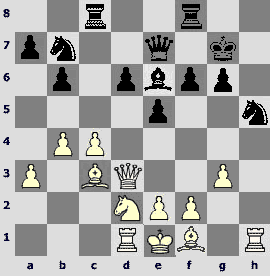
Now Black is only somewhat worse positionally. However, it turns out that the assessment is less important than the tendency.
21.e4
Locking the h1-a8 diagonal was wrong. 21.Ґg2!?.
21...¦h8 22.Јe3 ¤d8 23.f4 ¤f7
The most important maneuver in the game – the knight finally comes to a decent square!
24.Јf3
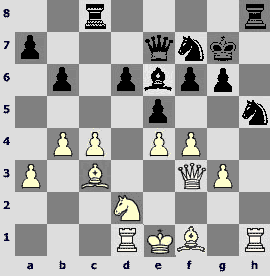
24...b5! 25.Ґe2
25.cxb5 exf4 26.gxf4 ¤xf4„.
25...¤xg3! 26.¦xh8 ¦xh8 27.Јxg3 ¦h3 28.Јg2 ¦xc3T
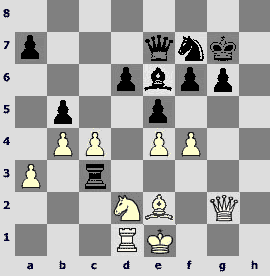
29.f5 Ґxc4 30.¤xc4 bxc4 31.Јxg6+ ўf8 32.¦d5 a6! …Јa7 33.ўd2 ¦xa3 34.Ґh5 ¤g5 35.ўc2 ¤xe4 36.ўb2 ¦g3 37.Ґg4 Јa7
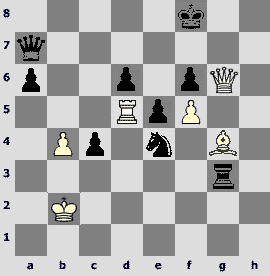
38.¦d2 c3+ 0-1
The Higher League
Dobrov-Kolesnikov
1.d4 d5 2.c4 e6 3.¤c3 c6 4.e4 dxe4 5.¤xe4 Ґb4+ 6.Ґd2 Јxd4 7.Ґxb4 Јxe4+ 8.Ґe2 ¤a6 9.Ґd6 b6
Soon only a lazy person will be ignorant about the Black's best continuation 9...e5 10.¤f3 Ґg4 11.0-0 0-0-0 12.Ґd3 Јf4 13.Ґxe5 Јxe5 14.¤xe5 Ґxd1.
10.¤f3 Ґb7 11.0-0 ¦d8
11...c5?! 12.¤h4 Јxh4? (12...0-0-0 13.Ґf3 Јxc4 14.Ґxb7+ ўxb7 15.Јf3+ Јd5 16.Јxf7+ ўa8) 13.Јa4+ ўd8 14.¦ad1 ўc8 15.Јe8+ Јd8 16.Јxd8+ ўxd8 17.Ґf8+ ўc7 18.Ґxg7 ¤f6 19.Ґxf6 ¦hg8 20.g3± Onischuk-Shulman, USA 2005;
It looks like 11...0-0-0 is correct, for example, 12.¦e1 Јg6 13.¤e5 Јf6 14.Ґf3 ¤e7 15.Ґxe7 ¦xd1 16.Ґxf6 ¦xa1 17.¦xa1 gxf6 18.¤xf7 ¦f8 19.¤d6+ ўc7 20.¤xb7 ўxb7 21.¦e1 is about even, Perez-Korneev, Padrun, 2003.
12.¤g5N
12.¤e5 ¤e7 13.¦e1 Јh4 14.g3 Јf6 15.¤g4 Јf5 16.Јd4 0-0 17.Ґd3 Јh5 18.Јf4 ¦fe8 19.¦ad1 ¤f5 20.Ґe5 Јg6 21.Ґb1© I.Sokolov-Vera, Portoroz, 1987.
12...Јf5 13.f4 ¤e7
13...h6 14.Ґg4 Јa5 15.¤xe6; 13...¤f6 14.g4!? Јg6 15.h4ѓ.
14.¦e1 Јf6 15.Ґh5
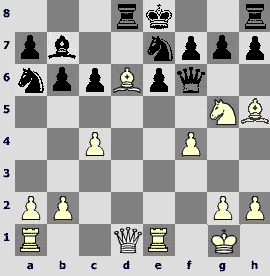
Black already stands badly.
15...0-0
15...g6 16.Ґe5 Јf5 (16...¦xd1 17.Ґxd1 Јf5 18.¤e4, and the queen is caught) 17.Јe2 0-0 (17...f6 18.Ґg4+-) 18.Ґg4 Јd3 19.Ґf6 Јxe2 20.¦xe2 – Black loses an exchange for a pawn.
16.Ґxf7+ ¦xf7 17.¦xe6

17...¤f5
17...Јf5 18.¤xf7+-.
18.¦xf6 ¦xf6 19.Јh5 ¦dxd6 20.Јxh7+ ўf8 21.¦e1 ¤e7 22.Јe4 ¦d7 23.¤h7+ ўe8 24.¤xf6+ gxf6 25.Јg6+ ўd8 26.Јxf6+- 1-0
Kazhgaleev-Evdokimov
1.d4 ¤f6 2.c4 c5 3.d5 g6 4.¤c3 Ґg7 5.e4 0-0 6.h3 d6 7.Ґd3 e6 8.¤f3 exd5 9.exd5 Јe7+
A rare move, which is normally met by 10.Јe2, trading the queens. Alexey Aleksandrov tried 10.ўf1, but without much success. Here White acts by analogy with 9...¦e8+, after which Black can trade the dark-squared bishops.
10.Ґe3 Ґh6 11.Јd2 Ґxe3 12.Јxe3 ¦e8 (I think it is better to take on e3, slightly damaging the White's pawn structure)
13.Јxe7 ¦xe7+ 14.ўd2 Ґd7
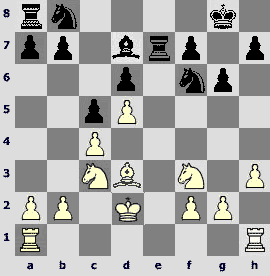
15.¤g5!± ¤a6 16.¤ge4 ¤e8 17.¦ae1 ўf8 18.g4 h6 19.a3 f5
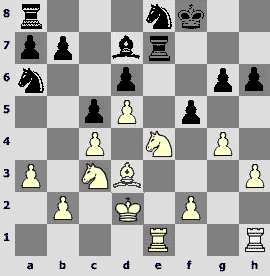
20.¤g3 ¤g7 21.gxf5 gxf5 22.¦eg1 ¤c7 23.¤ge2 ўg8 24.¦g6 ўh7 25.¦hg1 ¤ce8 26.¤f4±

26...a6 27.¤d1! b5 28.¤e3 bxc4 29.¤xc4 ¦b8 30.ўc3 Ґa4 31.¤e6
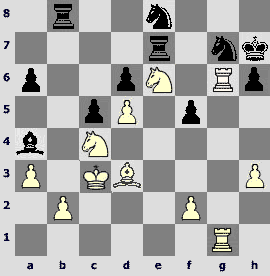
31...¦xe6 32.dxe6 d5 33.¤e5 (33.¤d6!?) 33...¦b3+ 34.ўd2 c4 35.Ґb1 ¦xb2+ 36.ўc1 ¦xf2 37.¤d7 ¦f1+ 38.ўd2
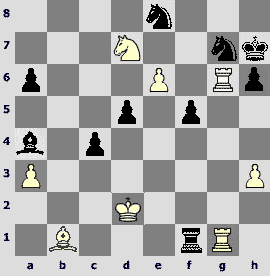
38...¦xg1 (38...¦xb1 39.¦xg7+ ¤xg7 40.¤f6+ ўh8 41.¦g6!+-) 39.¦xg1 d4 40.¤e5 ¤d6 41.e7 Ґb5 42.Ґa2 a5 43.¦c1 ¤ge8 44.a4 Ґa6 (44...c3+ 45.ўe1 Ґxa4 46.¤f3 d3 47.¦xc3±) 45.ўc2 f4 46.¦f1 d3+ 47.ўd1 Ґc8 48.¦xf4 Ґxh3 49.¤xc4 ¤f5 50.¤e5 ¤e3+ 51.ўd2 1-0
Anisimov-Kazhgaleev
1.e4 e5 2.¤f3 ¤c6 3.Ґc4 Ґc5 4.c3 ¤f6 5.d3 a6 6.0-0 d6 7.Ґb3 0-0 8.h3 Ґa7 9.¦e1 h6 10.¤bd2 ¤e7 11.¤f1 ¤g6 12.d4

12...b5!?
A good example of shaking the balance in order to play for a win as Black, if your opponent acts exaggeratedly solid.
13.¤g3 Ґb7 14.Ґc2 ¦e8 15.a4 exd4 16.cxd4 c5 17.d5 c4 18.¤f5 b4 19.a5 Ґc5 20.b3 c3 21.¤3d4 Ґc8 22.g4
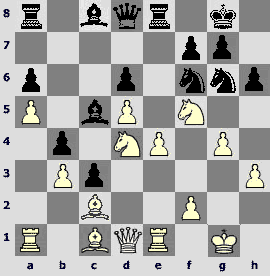
22...¤h7 23.Јd3 Јf6 24.¤c6 ¤h4 25.Ґf4
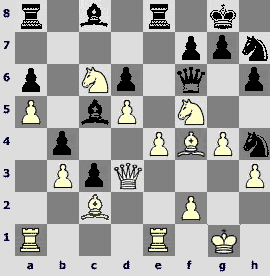
25...g6 26.¤xh4
26.e5 dxe5 27.¦xe5 Ґxf5 28.gxf5 ¤xf5µ
26...Јxf4 27.Јf3 Јd2 28.Јe2 ¤g5 29.ўg2 Јf4 30.f3 h5µ
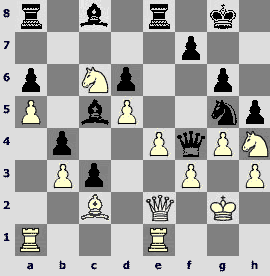
31.¦ad1 ўg7 32.¤d4 ¦h8 33.¦h1
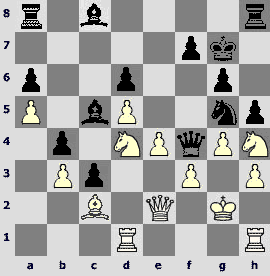
33...¤xh3 34.¦xh3 hxg4 35.¤hf5+
35.¦hh1 Ґxd4 36.¦xd4 ¦xh4 37.¦xh4 gxf3+ 38.Јxf3 Јxh4 39.¦xb4 Јg5+-+.
35...Ґxf5 36.¤xf5+ (36.¦xh8 ¦xh8-+) 36...gxf5 37.¦g3 ¦h4 38.exf5 ¦ah8 39.f6+ ўxf6 0-1
Lanin-Tseshkovsky
1.e4 d6 2.d4 g6 3.¤c3 Ґg7 4.f4 ¤f6 5.¤f3 0-0 6.Ґd3 ¤a6 7.0-0 c5 8.d5 ¦b8 9.f5 b5
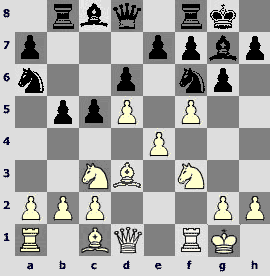
The main book move is 9...¤b4.
10.fxg6 hxg6 11.Ґxb5 ¤xe4 12.¤xe4 ¦xb5 13.Јe1 ¤c7 14.Јh4 f6 15.c4 ¦b7 16.Ґd2 ¦f7
16...¦xb2 17.Ґc3 ¦c2 18.¤fg5 fxg5 19.¤xg5 ¦f6 20.Јh7+ ўf8 21.Јxg6+-.
17.Ґc3 Ґf5
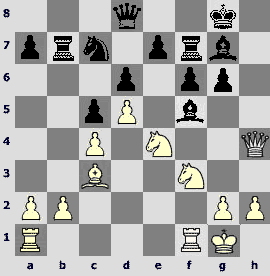
18.¤eg5! fxg5 19.¤xg5 Ґxc3
19...¦f6 20.g4
20.¤xf7 ўxf7
20...Ґd4+ 21.Јxd4+-.
21.bxc3 ўg7 22.g4 Ґd3 23.¦f3 ¦b1+
Similarly 23...Ґb1 24.¦h3+-.
24.¦xb1 Ґxb1 25.¦h3+- ўf7 26.Јe1 e5 27.dxe6+ ¤xe6 28.¦f3+ Ґf5 29.gxf5 ¤g5 30.fxg6+ ўg7 31.¦g3 Јf6 32.Јe3 ¤e6 33.¦f3 Јe5 34.Јxe5+ dxe5 35.¦f7+ ўxg6 36.¦d7 ¤g5 37.a4 1-0
